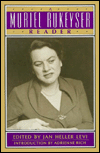Last week I examined some of the techniques Rukeyser used to write so powerfully about social concerns by looking at a single poem. This week I want to look at some additional aspects of her craft. In doing so, I’m indebted to the participants in my Poetry Discussion Group for their insights.
Born a few months before the assassination of Archduke Franz Ferdinand and his wife Sophie in Sarajevo, Rukeyser’s life was clouded by the wars of the twentieth century. She was in Barcelona at the start of the Spanish Civil War, and traveled to Hanoi in opposition to the Vietnam war near the end of her life. In “Poem”, she writes:
I lived in the first century of world wars.
Most mornings I would be more or less insane,
The newspapers would arrive with their careless stories,
The news would pour out of various devices
Interrupted by attempts to sell products to the unseen.
I would call my friends on other devices;
They would be more or less mad for similar reasons.
This opening is remarkable for a couple of reasons. One is the ambivalent tone of the first line. Is she being melodramatic, self-pitying, or merely stating a fact? Our curiosity is aroused—or mine was, at least. The next few lines, with their wryly humorous, matter-of-fact description of her morning, confirm the latter.
The other rather remarkable aspect is how contemporary these details seem. “More or less insane” is a good description of how I feel ingesting the news these days. And “devices”? Of course, she couldn’t know what that term would come to mean fifty years after the poem was published, but it is an inspired choice.
At this point in the poem, having made us chuckle and pay attention, Rukeyser changes the focus. Using two lines as a transition, she creates a hinge in the poem. We leave the news, the friends, the morning behind and plunge into why she is writing poetry and what poetry can do to heal our horribly damaged world.
Slowly I would get to pen and paper,
Make my poems for others unseen and unborn.
In the day I would be reminded of those men and women,
Brave, setting up signals across vast distances,
Considering a nameless way of living, of almost unimagined values.
As the lights darkened, as the lights of night brightened,
We would try to imagine them, try to find each other,
To construct peace, to make love, to reconcile
Waking with sleeping, ourselves with each other,
Ourselves with ourselves. We would try by any means
To reach the limits of ourselves, to reach beyond ourselves,
To let go the means, to wake.
Then she ends by repeating—with a slight variation—the first line. No longer ambivalent, it now is filled with emotion which overflows in our own hearts.
I lived in the first century of these wars.
We see these techniques—repetition, hinges, humor—in many of her poems. We also see her use of imagery. In some poems she throws out images with seemingly reckless abandon, with a cascade of images that in a literal sense seem unrelated, yet placed with precision yield a thrilling experience. In an interview, she said she needed “a language that was not static, that did not see life as a series of points, but more as a language of water.”
Her poem “Reading Time: 1 Minute 26 Seconds” is an example of this cascade of images, as well as the use of repetition and vowel sounds to drive the emotional content of the poem. If you actually read it aloud—rapidly, in order to match the designated reading time—the power will come through even more intensely.
The fear of poetry is the
fear : mystery and fury of a midnight street
of windows whose low voluptuous voice
issues, and after that there is not peace.The round waiting moment in the
theatre : curtain rises, dies into the ceiling
and here is played the scene with the mother
bandaging a revealed son’s head. The bandage is torn off.
Curtain goes down. And here is the moment of proof.That climax when the brain acknowledges the world,
all values extended into the blood awake.
Moment of proof. And as they say Brancusi did,
building his bird to extend through soaring air,
as Kafka planned stories that draw to eternity
through time extended. And the climax strikes.Love touches so, that months after the look of
blue stare of love, the footbeat on the heart
is translated into the pure cry of birds
following air-cries, or poems, the new scene.
Moment of proof. That strikes long after act.They fear it. They turn away, hand up, palm out
fending off moment of proof, the straight look, poem.
The prolonged wound-consciousness after the bullet’s shot.
The prolonged love after the look is dead,
the yellow joy after the song of the sun.
Rukeyser’s work is so rich I could devote many more weeks to talking about aspects of her craft, such as her use of colons and tabs. I mentioned last week her interest in science and the intersection of science with poetry. I especially like the use she makes of James Clerk Matthews’s discussion of the mathematical concept of “singular points” as a “moment of great height, of infinite depth.”
In The Life of Poetry, Rukeyser talks of the influence of Melville and Whitman, one “the poet of outrage”, the other “the poet of possibility”, and we can see both of these influences in the poems we’ve looked at this week and last. She also speaks of different sorts of unity: unity of imagination, of images, and so on. She embraces the possibility of our coming together, of our finally bringing an end to war.
Do you have a favorite poem by Muriel Rukeyser?
